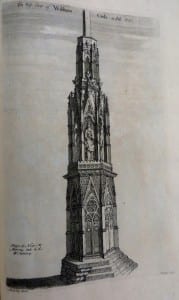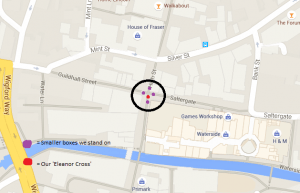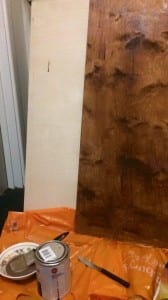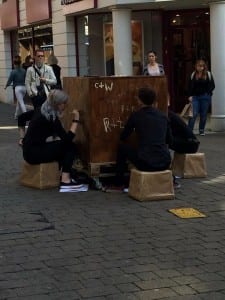Framing Statement
Eleanor and Edward, 1254 is a piece celebrating the relationships of the people of Lincoln, it contains both installation and performance elements, and was performed on 5th May 2016. It is influenced by the story of Edward I, his wife Eleanor and the Eleanor Cross. Upon Eleanor’s death “Edward ordered for crosses bearing statues of the Queen to be erected at places where the [funeral] procession stopped overnight. (Eliot, 2008). This piece was influenced by multiple theorists such as Marc Augé’s Non-Places: Introduction to an Anthropology of Supermodernity. and pieces of site-specific performance for example Lee Miller and Joanne Whalley’s 2003 Site-Specific Performance Partly Cloudy, Chance of Rain. These influences will be explored in the analysis of our process.

(A drawing of the Lincoln Eleanor Cross. Available from: https://researchwelllincolnshire.wordpress.com/2013/08/28/the-eleanor-cross-at-lincoln/)
Framing Statement: The Performance
As a group we created a procession with an invited audience from the path before the railroad tracks up to Stonebow. This mirrored the last trip Eleanor and Edward took together from London to Lincoln, where she died. Here we placed a large wooden box; our version of the Eleanor Cross. On the box are carvings, these are the initials and dates of couples who’s stories we have gathered over our creative process. We then formed a cross with the large box in the middle using smaller boxes which we stood on:
(A diagram I made presenting the location we stood at and the cross formation we were in.)
Once in position one member of the group walked to the large box in the centre. When they were there they called out the first 3 locations the Eleanor Cross was built at, then began carving more initials and dates from the stories we’ve gathered. The rest of the group began to tell the stories of the couple’s we’ve spoken to during this process. This was mainly in a town crier fashion, inspired by earlier research into Speakers Corner but if parts of the story don’t fit with this style, we would step off the boxes that we are standing on to tell them. This rule also applied to speaking to audience members. After around 3 minutes the carver stopped and went and stood on their box, another member of the group walked to the large box, called out the next 3 locations the Eleanor Cross is built in, and the process began all over again. Once each member of the group had been a carver we each took our smaller boxes, stood around the large box and one by one called out “Eleanor and Edward, 1254” before sitting and carving. Once the performance was over we walked back down the High Street to our original location in a procession with the large box. This mirrors the funeral procession for Eleanor. The performance itself takes around 20 minutes and for the hour before the performance we carved into the box at the starting location.
Our audience is invited to the procession at the beginning of our piece meaning they take an active role within it. This also means they help to bring the performance to life. This was primarily inspired by a video by Joshua Sofaer called What is Live Art?. In it Sofaer explains that Live Art “comes into being at the actual moment of encounter between the artist and spectator”. (Sofaer, J. 2011.) This is very much the case in our piece and prior to the audience joining as a procession we are not performing. After this we can only interact with our audience when we are not stood on the boxes being town criers. To come off the boxes means to come out of role, meaning we can tell more detailed love stories and talk to our audience.
Analysis of Process
The first weeks of this process focussed on ensuring we had a good background knowledge of Site-Specific Performance and the theory behind it. This meant that groups and ideas could begin to form. A good summary of what was explained to us comes from Michael Pearson’s Site-Specific Performance:
“[Site specific performance] refers to a staging and performance conceived on the basis of a place in the real world…A large part of the work has to do with researching a place.” (Pearson, M. 2010, 7)
At the beginning of this process I became interested in Mark Auge and his book Non-Places: Introduction to an Anthropology of Supermodernity. In this book Auge deals with the idea of a location either being a place or non-place:
“If a place can be defined as relational, historical and concerned with identity, then a space which cannot be defined as rational or historical or concerned with identity will be a non-place” (Auge, M. 2009, 27)
Taking this definition is it easy to define the High Street which is my site for this module, as a non-place. Although it can be argued that it does contain the above factors, the High Street is a place of transit. It is not usually a place for social interaction and the history behind it is left unknown to many who travel through it. After establishing this I decided I wanted to create a place within the High Street, and taking Auge’s idea that “the social begins with the individual” (Auge, M. 2009, 19) I wanted to do this through the people that transit through. This idea is supported by Tim Ingold who says that “a place owes its character to the experiences [of] those who spend time there”. (Ingold, T. 2000, 26) Having solid theory behind my idea of using the people of Lincoln to create a place in my performance I decided that I wanted to focus on people’s relationships, which Pearson supports stating that “places are about relationships”. (Pearson, M. 2010, 14)
Once groups were formed in the first few weeks I explained my desire to do a piece based around relationships. The group agreed to make this the theme after some research within the city. Whilst looking for possible places in our site to inspire ideas we stopped outside Lakeland. Noticing that the building looked like it could’ve been a court, we went into the shop to investigate. We were informed that it was in fact the location of the old train station, and within Lakeland was an original timetable from it. (Pictured below) A member of staff within the shop explained that it continued on through to Argos and that they had some original photos in the store. We moved on to Argos to look at these photos, and whilst doing so an elderly couple approached us telling us that they remembered when the station was originally there. The gentleman explained that he took the train from Lincoln to Newark to see the woman who is now his wife. This story gave us confirmation that our theme of romance would create an interesting and captivating performance. It also confirmed that couples will be willing to tell us their stories, and that it won’t just be our peers that want to take part.
(A picture I took of the old railroad timetable in Lakeland)
Now that the theme was established a recent debate that took place in class brought across the concern of invading our audience’s privacy. We were influenced by Sophie Calle’s work in which she follows people around Paris to reconnect with the city. We wanted to take this idea and use the people’s stories of romance to allow our audience to reconnect with Lincoln in a new way. Calle’s work however sparked a debate about where art and performance crosses the line into invasion of privacy. In her book Suite Vénitienne she describes following a man out of Paris:
“At the end of January 1980, on the streets of Paris, I followed a man whom I lost sight of a few minutes later in the crowd. That very evening, quite by chance, he was introduced to me at an opening. During the course of our conversation, he told me he was planning an imminent trip to Venice. I decided to follow him.” (Calle, S. 2015, 2)
This spurred further research into Calle’s work during which I discovered her observation goes far into the region of invading privacy. In her work, The Hotel, Room 47 she “was hired as a temporary chambermaid”. (Tate, 2005) Her observing included reading letters and diaries of the guests, listening through the hotel doors at their conversations, even spraying herself with their perfumes and eating their left over food. This research has resulted in our groups desire to avoid any possible violation of people’s privacy. We still want our audience to connect with Lincoln through people’s personal stories but any information obtained from audience members will be done with their consent for it to be used in performance.
The next task was to decide upon a location. We were immediately drawn to the building in the centre of Speakers Corner (see picture below) due to the ability to attach things to it, and the intricate designs connecting the poles. This was because our idea at the time was to decorate our site with the stories of the couples we’d spoken to, along with photos and flowers, whilst we pose as Town Criers which we felt appropriate because of the location, declaring the stories. To justify our decision I researched Speakers Corner and Town Criers. I discovered that Speakers Corner only came to be in 2010, and a Lincolnshire Echo article from 2011 explained that “since its launch Lincoln’s Speakers’ Corner has remained virtually silent”. (Lincolnshire Echo, 2011) Due to the lack of historical background, and lack of relation to our theme of romance we decided against using this location.
(A picture I took of the building at Speakers Corner)
The research into Speakers Corner reiterated to our group the importance of the history of a place to Site-Specific Performance. Miwon Kwon supports this in her book One Place after Another, explaining that “site-specific art can lead to the unearthing of repressed histories”. (Kwon, M. 2004, 53) During my research into Speaker’s Corner I came across the story of Eleanor and Edward I, and realised I had seen this story before in Argos when our group was talking to Colin and Cathy (see picture below). The group agreed that to recreate our own Eleanor Cross to celebrate the couples in Lincoln today was the best way to uncover the history of our site and the history of the people that transit through it every day. However due to the fact the original has a religious symbol on it, we couldn’t do an exact replica, but we felt this fit with our intention of modernising this declaration of love for our current audience. As well as the cross itself we wanted to recreate other parts of this story, such as the last journeys taken by the couple, from London to Lincoln together, and Lincoln to London after Eleanor had passed away. This lead to the idea of mimicking the journey through a procession with our Cross from near the railroad tracks which is a direct link to London up to Stonebow as the street continues up to the Cathedral, where the original Eleanor Cross is, and then back down. In addition to this Stonebow allowed us to create a cross formation, adding another level of reference to our piece.
(A picture I took of the display in Argos)
Throughout this process we had been obtaining couple’s stories via social media but wanted to obtain them from people personally. Taking inspiration from Lee Miller and Joanne Whalley’s 2003 piece Partly Cloudy, Chance of Rain during which they exchanged bottles of urine they found on the road with personal items of their own we decided we would exchange love stories for flowers. They did this because “knowing that these were the product of people, [they] felt uncomfortable about simply taking them, and so it was decided that [they] would make an exchange”. (Whalley, J. and Miller, L. 2003) People on the High Street weren’t very responsive to this and didn’t want to interact with us. So instead we decided to allow our audience to approach us while we were carving the box, and we would carve the initials of them and their partner in exchange for their story.
In the final weeks we showed our work to Steve our Lecturer and Conan the Module Leader. The response we received was overall positive. They suggested that when telling our stories we be on some form of box, to add to the position of Town Crier and only talk on the boxes in a Town Crier fashion. This lead to us deciding to only talk to audience members and tell detailed love stories when off the boxes. They also suggested painting the cross so that the carving stands out more. The pictures below shows that this made a huge difference to the appearance of our piece. Other than these changes they were ultimately happy and our final piece was ready to be performed.
(Left: A picture Chris took of the wood before and after it was painted Right: A picture Rayanne took of the box carved into.)
Performance Evaluation
Our performance was as described in the ‘Framing Statement: Performance’ section of this blog. Before starting the performance we were carving at our start position and several people came and interacted with us, as we were not performing we were able to answer their questions in an informal manner. At 4pm we began our Procession and had an audience of around 3 walk with us up to Stonebow. Considering we had invited mostly our peers, a lot of whom were also doing their performances at the time, this number wasn’t unexpected. The amount of people who watched us at Stonebow was much larger, with people stopping in the street to watch our performance, as well as invited audience joining them throughout. In terms of interaction it was limited, not many people approached us. I believe this was because of the performance’s theatrical style, the audience felt like they shouldn’t intrude. This included a vehicle that was trying to go through the High Street, rather than interrupting us to move they allowed us to perform. We weren’t aware that this vehicle was waiting until an audience member told us afterwards. I believe this shines a positive light on our performance as audience members were willing to stop in transit to watch. Confirming that we had succeeded in creating a place through relationships in a non-place, a place of transit. Other than this the strongest moments of the piece were those in which we told more detailed stories, they appeared to flow better and engaged the audience more than simply calling out names and dates. Improvements in this piece certainly would have come from more rehearsal, visually it was captivating but the speech was sometimes sloppy meaning the town crier effect was lost. If I were to perform this piece again rehearsing the piece more would be essential. In terms of changing other aspects I would want more audience participation as the people of Lincoln are the driving force for this piece. I would want to ask audience members for their love stories during the performance, perhaps getting them to stand on the boxes and declare their love and the story behind it.
Site-Specific Performance was something I had never done before, nor had I ever performed in a non-traditional venue and so this was very much a learning experience. Through a variety of theorists and studying other performances I have learnt the importance of a performance location and the impact it can have on your piece. By looking into the history of Lincoln, as advised to do by Michael Pearson’s definition of Site-Specific we discovered a love story that completely changed our performance and our view of the city ultimately creating a piece wildly different to the one we began with. “Site-Specific performance engages with the site as symbol, site as story teller, site as structure” [Pearson, M. 2010, 7) and this could not be truer of my experience of site-specific. Making a non-traditional venue into a symbol of love, telling the stories of its people and creating our very own Eleanor Cross as a result.
(Both photos are of our final performance taken by an audience member)
WORDS: 2729 (Including titles and captions)
References
Auge, M. (2009) Non-Places: Introduction to an Anthropology of Supermodernity. London: Verso.
Calle, S. (2015) Suite Venitienne. California: Siglio Press
Eliot, S. (2008) The Eleanor Crosses: A Love Story In Stone. [online] Available from: http://www.timetravel-britain.com/articles/history/eleanor.shtml [Accessed 27th April 2016].
Ingold, T. (2000) The Perception of the Environment. London: Routledge.
Kwon, M. (2004) One Place after Another. London: The MIT Press.
Lincolnshire Echo (2011) Bid to Break Silence at Lincoln’s Speakers Corner. Lincolnshire Echo, 27 July. Available from http://www.lincolnshireecho.co.uk/Bid-break-silence-Lincoln-s-Speakers-Corner/story-13016847-detail/story.html [accessed 6 March 2016].
Pearson, M. (2010) Site-Specific Performance. Basingstoke: Palgrave MacMillan.
Sofaer, J. (2011) What is Live Art? [online video] Available from https://www.youtube.com/watch?v=LOUxv4Do01g [Accessed 2nd March 2016].
Tate (2005) Sophie Calle: Room 47. Available from http://www.tate.org.uk/art/artworks/calle-the-hotel-room-47-p78300 [accessed 26 February 2016].
Walley, J. and Miller, L. (2003) Partly Cloudy, Chance of Rain: A Case Study. Available from http://repository.falmouth.ac.uk/99/1/RR_Partly%20Cloudy,%20Chance%20of%20Rain_190613_nid237.pdf [accessed 10 May 2016]












